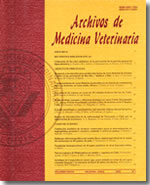Histopathological lesions in the liver of salmonids, from the X to XII Region of Chile. Frequency and distribution according to the age and the season of the year, 1988-1998
Main Article Content
Abstract
The purpose of this report was to analize the kinds of lesions present in livers of salmonids grown in fish farms in the Tenth to Twelfth Region of Chile, from 1988 until 1998, in relation to age and seasons. Anatomic-pathologic reports from the Animal Pathology Institute of the Veterinary Science Faculty, corresponding to: 319 coho salmon (O. kisutch), 184 Atlantic salmon (S. salar), 26 chinook salmon (O. tschawytscha) and 180 rainbow trout (O. mykiss), were analysed
The results of this research indicate that 45.0% of the total amount of liver samples received (from 1988 until 1998), corresponded to coho salmon. The largest percentage of liver samples received corresponded to smolts and 53.0% of them corresponded to coho smolts.
Most of the liver samples were received between 1989 and 1992, mainly in summer. Their aetiology was related to the presence of Piscirickettsia salmonis, that produces "Salmonid Rickettsial Septicemia" (SRS). A second peak was noticed between 1994 and 1996, increasing in autumn. This was attributed to the presence of "Limphoblastic Leukemia" (LL).

